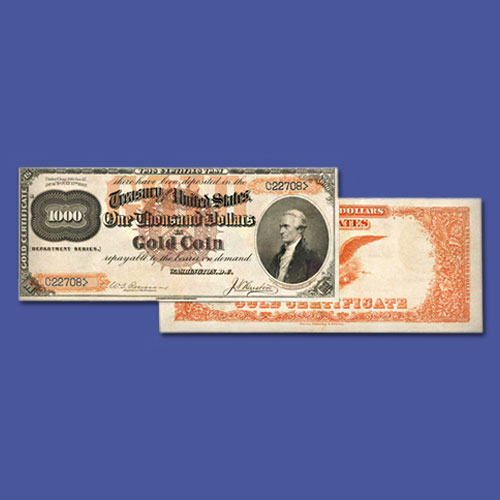Rare and Fine 1882 $1000 Gold Certificate
2018-07-13 Fri
19th-century Gold Certificates are rare because almost all of them were held privately and were not exported like double eagles and other gold coins. Metallic gold was mostly preferred over paper money for reserves by foreign treasuries. However, double eagles were exported in large numbers and millions have been returned since World War II.Almost all existing Gold Certificates of the 19th century are of lower denominations. The Anderson $1,000 note is the highest denomination in its series and is also the finest out of the two known examples. The 1882 $1,000 Gold Certificate, graded Currency Extremely Fine 45 is a part of the Joel R. Anderson Collection and will be offered by Stacks and Bowers very soon for a record price.
The note features a portrait of Alexander Hamilton, a large brown spiked Treasury Seal with GOLD overprinted in gold letters, a large 1000 counter, bold blue serial numbers within gold panels, the engraved signatures of Rosecrans and Huston. The reverse features intricate designs in orange-gold with a bald eagle with shield and a large Roman numeral M counter.
There is a record of only four examples of this catalogue number. Two are a part of the National Numismatic Collection at the Federal Reserve Bank of San Francisco. The offered note was the only privately held example known until 2013 when another example was discovered. The second example was graded Very Fine 35 by PCGS and sold for $881,250 in 2014. The offered note has bright paper, bold inks and was not circulated much. The note would be offered with an estimated price of $600,000-$800,000.
Image Courtesy: Stacks and Bowers
Latest News
-
Mahatma
2024-04-25 ThuIndia Post issued a commemorative postage stamp on #LalaHansraj, also known as Mahatma Hansraj for�...
-
Berar Mint of Muhammad Akbar
2024-04-25 ThuBerar was a kingdom located in the Deccan region, with Elichpur as its capital. It was one of the Su...
-
Janma Kalnayak of Bhagwan Mahavir
2024-04-24 WedOn 21st April 2024 which was the 2550th Janma Kalnyanak of Bhagwan Mahavir Swami, PM Modi unveile...
-
Gold Pagoda of Vijaynagar Empire King Deva Raya I
2024-04-10 WedKing Deva Raya I of the Vijayanagara Empire was a patron of Kannada literature and architecture. He ...
-
Silver Denarius of Septimus Severus
2024-04-05 FriLucius Septimius Severus served as the Roman emperor from 193 to 211 AD. Severus sat on the throne o...

